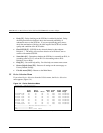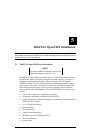
EK–KZPCM–UG. B01 4–1
4
Windows NT Installation
This chapter describes briefly the SYMC8XX.SYS miniport driver that enables the
KZPCM Host Adapter to work with the Windows NT operating system, version 4.0, and
tells you how to install the driver in the host computer.
4.1 SYMC8XX.SYS Miniport Driver Description
The Windows NT operating system, version 4.0, is designed to run on processors
using Intel and RISC technology. The operating system provides a graphical user
interface environment, without DOS, incorporating many high-level features. I/O
requests in Windows NT 4.0 are handled by an I/O manager. To address a SCSI
peripheral the I/O manager goes through the appropriate drivers. Class drivers for
hard disk, optical, CD-ROM, printer, and scanner peripherals are provided in
Windows NT 4.0. Other class drivers, provided by peripheral manufacturers, are
added to support new devices. Tape device support is built into the operating
system itself and does not require a class driver. The SYMC8XX.SYS miniport
driver is added to complete the path from the Windows NT operating system to
the KZPCM Host Adapter.
The driver is designed to meet Microsoft specifications for miniport drivers.
SCSI commands are passed directly from a Windows application to the SCSI
devices by using the SCSI pass-through facility. This facility allows applications
to control and access SCSI devices directly by filling in a data structure and
calling into the port driver.
The SYMC8XX.SYS driver supports Fast 20/Ultra SCSI protocol, providing
twice the raw data transfer rate of Fast SCSI for disk drives and host adapters
that support Fast 20/Ultra SCSI. However, Fast 20/Ultra SCSI has more stringent
SCSI bus cabling requirements than Fast SCSI. The SYMC8XX.SYS driver
supports:
•
Synchronous negotiation (including Fast/Ultra SCSI)
•
Wide negotiation
•
Tagged command queuing
•
Multiple host adapters


















